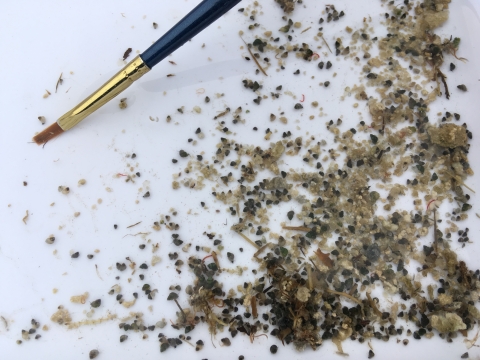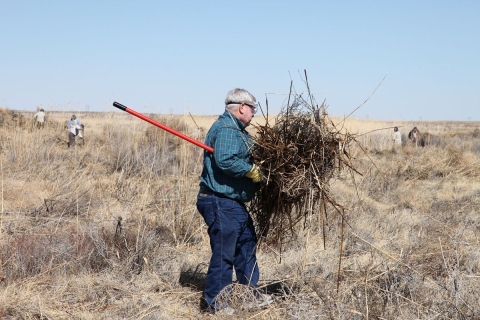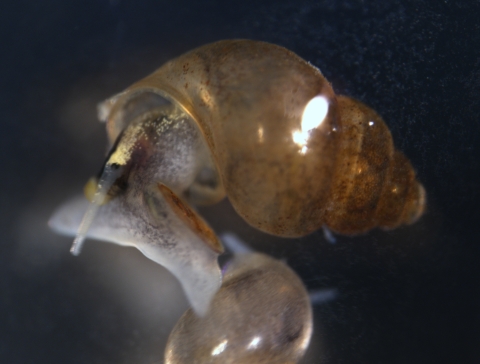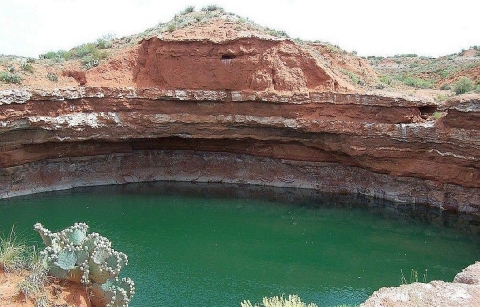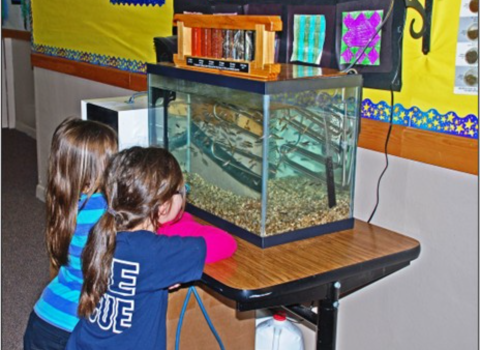Take a pen and look at the tip and try to bring into focus the ball point that rolls and puts ink onto paper. It’s tiny, right? That’s what it’s like to look at some springsnail species. If you live in the western U.S. and enjoy spring-influenced wetlands, chances are you’ve seen them, even if you didn’t notice them. They are often less than 2 millimeters long, like a grain of sand that, if you look closely, has a little conical swirl.
Certain springsnail species are so small that you need a microscope in order to tell them apart. It may come as a surprise that there are animals of this size. What may come as an even bigger surprise is that many of these granular critters make their home in deserts, like a symbol of life's determination to thrive against all odds.
They may seem insignificant, but they are important indicators for vital spring systems on which we all depend, they improve water quality, keeping algae in check, and aiding in energy transfer in and balance in their stream and spring seep ecosystems. However, many desert springsnails face a challenge greater than the harsh environments where they survive. They’re losing their habitats due to human activity.
Thanks to the Endangered Species Act, there are resources for other human activities to restore these habitats so that the springsnails can continue to thrive. In recent years, the biologists on the U.S. Fish and Wildlife Service’s Bitter Lake National Wildlife Refuge near Roswell, New Mexico, have helped gain a footing for two springsnail species (Koster’s and Roswell springsnail).
What they did was groundbreaking, setting new standards in springnsail habitat restoration. It took years of labor, planning, and even changing a river’s course. The work started with removing invasive wetland plants in the Bitter Creek system and culminated with re-routing a river.
“By the time I arrived at the Refuge, the whole Bitter Creek system was being choked out by invasive common reed and salt cedar,” told Jeff Sanchez, former Bitter Lake NWR biologist who led the restoration project until 2015. He’s now the refuge manager at Sevilleta National Wildlife Refuge in central New Mexico. “These plants were outcompeting the native plant community, slowing the flow of water, changing the temperature and oxygen levels.”
Over a course of three years, the refuge staff removed virtually all the invasive reeds. They began to see Koster’s springsnail populations improve, but that wasn’t all. The threatened Pecos sunflower began bouncing back in the area, along with the endangered, land-dwelling Pecos assiminea snail, and the endangered Noel’s amphipod, an aquatic crustacean. This serves as proof that when you improve habitat for one native species, it often benefits others.
The restoration project wasn’t complete with the removal of those invasive plants within the Bitter Creek system on the Refuge. At another spring system on the Refuge, the biologists found potential habitat to support a good population of the endangered invertebrates, but there was a problem with the water quality. Noel’s amphipod existed in this Rio Hondo spring system, but it couldn’t thrive due to contamination from a nearby river that had been previously modified. Exhibiting similar conditions as the other springs, the scientists saw that if they could improve the conditions for the amphipod in the Rio Hondo springs, it would also be suitable for the springsnails.
“Success in the Bitter Creek system lead the refuge staff to turn their attention to the Rio Hondo. Jeff Sanchez and others on the project saw that to improve conditions of the Rio Hondo springs, they needed to reroute the Rio Hondo,” explained Bill Johnson, a natural resource biologist with the Service, who, along with Sanchez and others, penned a 2022 scientific paper on this improvement to springsnail habitat. The Rio Hondo spring system is separate from the river of the same name. “The Rio Hondo wasn’t pristine. It had been dredged out, deepened, and served basically as a drainage ditch that Roswell needed to prevent flooding. Because of that, when these storms happened, the Rio Hondo would rise tremendously and inundate the springs.”
Spring systems are delicate. Each is a microcosm of a unique mineral makeup that seeps up from underground spring flows. At the Refuge, the springs are known for alkalinity and salinity. These conditions have been in place for millennia. Unique invertebrates have adapted to this specific environment, separated from other bodies of water by arid desert grassland. These types of systems primarily exist in deserts. When a surge of rainwater washes into the systems along with gobs of mud and sediment, as was happening in the Rio Hondo prior to the enhancement project, it degrades that spring’s unique conditions, making it inhospitable to much of the native life.
The Refuge staff applied for and received special funding to improve springs and went to work with heavy earth-moving machinery, modifying the path of the Rio Hondo so that it would take a more direct course to the Pecos River instead of meandering near the formerly inundated springs. To protect the system from seepage, an earthen dam was constructed and lined with rock to prevent erosion. After the work was complete, the refuge transplanted both Koster’s and Roswell springsnails into the system. Monitoring, which continues to this day, shows that both species have thrived and spread throughout the system.
At this point, you might be wondering Why? Why dedicate so much effort into protecting desert springs? Why move a river and build a dam for these tiny mollusks that you need a microscope to tell apart?
“People often ask me this,” replied Johnson. “The reason you should care about these snails is because of the habitat. Their presence indicates healthy groundwater, which is important for larger animals that drink from the spring. Their position in the food chain helps balance ecosystems that support other wildlife. Unfortunately, desert springs are disappearing throughout the Southwest, but by conserving these endangered springsnails, we rally conservation resources to keep this spring system around not just for the springsnails, but for other wildlife, for you and me, and for future generations to enjoy.”
“Everything is important and has its place,” remarked Sanchez. “Many of these species are only found here. They deserve their own little space in the world.”
You can visit this space at the Bitter Lake National Wildlife Refuge and enjoy this hard-won oasis without paying any fee.
The restoration and continued support of these springs was made possible by labors of innovative scientists working toward goals outlined in the Endangered Species Act, which marks it’s 50th Anniversary in 2023. Considered one of the world’s most important conservation laws, it’s prevented the extinction of hundreds of imperiled species like the Koster’s and Roswell springsnails.
Each of these species is a part of the web of life, each with a unique cultural and biological community, performing services that are essential to our combined well-being. By conserving them, we help ensure the benefits that accrue from them—healthy air, land, and water—on which we depend.


